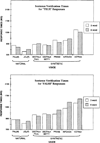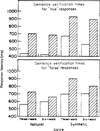Comprehension of synthetic speech produced by rule: a review and theoretical interpretation
- PMID: 1339919
- PMCID: PMC3507427
- DOI: 10.1177/002383099203500401
Comprehension of synthetic speech produced by rule: a review and theoretical interpretation
Abstract
In this paper, we review research on the perception and comprehension of synthetic speech produced by rule. We discuss the difficulties that synthetic speech causes for the listener and the evidence that the immediate result of those difficulties is a delay in the point at which words are recognized. We then argue that this delay in processing affects not only lexical access but also comprehension processes. We consider the mechanisms by which the comprehension system adjusts to this delay, the resulting costs to higher level comprehension processes, and the changes that occur in the language processing system as its familiarity with synthetic speech increases. Based on the framework we have developed, we suggest several directions for future research on the comprehension of synthetic speech.
Figures










Similar articles
-
Comprehension of synthetic speech produced by rule: word monitoring and sentence-by-sentence listening times.Hum Factors. 1991 Aug;33(4):471-91. doi: 10.1177/001872089103300408. Hum Factors. 1991. PMID: 1835449 Free PMC article.
-
Out of sight, out of mind: The influence of communicative load and phonological neighborhood density on phonetic variation in real listener-directed speech.J Acoust Soc Am. 2022 Jan;151(1):577. doi: 10.1121/10.0009233. J Acoust Soc Am. 2022. PMID: 35105023
-
Effects of noise and speech intelligibility on listener comprehension and processing time of Korean-accented English.J Speech Lang Hear Res. 2010 Dec;53(6):1543-54. doi: 10.1044/1092-4388(2010/09-0100). Epub 2010 Aug 10. J Speech Lang Hear Res. 2010. PMID: 20699339
-
Synthesized speech output and children: a scoping review.Am J Speech Lang Pathol. 2010 Aug;19(3):259-73. doi: 10.1044/1058-0360(2010/09-0024). Epub 2010 Jun 11. Am J Speech Lang Pathol. 2010. PMID: 20543017
-
The time-course of speech perception revealed by temporally-sensitive neural measures.Wiley Interdiscip Rev Cogn Sci. 2021 Mar;12(2):e1541. doi: 10.1002/wcs.1541. Epub 2020 Aug 7. Wiley Interdiscip Rev Cogn Sci. 2021. PMID: 32767836 Review.
Cited by
-
Influence of Turn-Taking in Musical and Spoken Activities on Empathy and Self-Esteem of Socially Vulnerable Young Teenagers.Front Psychol. 2022 Feb 7;12:801574. doi: 10.3389/fpsyg.2021.801574. eCollection 2021. Front Psychol. 2022. PMID: 35197885 Free PMC article.
-
Three challenges for future research on cochlear implants.World J Otorhinolaryngol Head Neck Surg. 2018 Jan 2;3(4):240-254. doi: 10.1016/j.wjorl.2017.12.010. eCollection 2017 Dec. World J Otorhinolaryngol Head Neck Surg. 2018. PMID: 29780970 Free PMC article. Review.
-
Interpreting chicken-scratch: lexical access for handwritten words.J Exp Psychol Hum Percept Perform. 2010 Aug;36(4):906-23. doi: 10.1037/a0019258. J Exp Psychol Hum Percept Perform. 2010. PMID: 20695708 Free PMC article.
-
The acceptability and validity of AI-generated psycholinguistic stimuli.Heliyon. 2025 Jan 17;11(2):e42083. doi: 10.1016/j.heliyon.2025.e42083. eCollection 2025 Jan 30. Heliyon. 2025. PMID: 39906842 Free PMC article.
-
Effect of speaking rate on recognition of synthetic and natural speech by normal-hearing and cochlear implant listeners.Ear Hear. 2013 May-Jun;34(3):313-23. doi: 10.1097/AUD.0b013e31826fe79e. Ear Hear. 2013. PMID: 23238527 Free PMC article.
References
-
- Allen J, Hunnicutt MS, Klatt D. From Text to Speech: The MITalk System. Cambridge, UK: Cambridge University Press; 1987.
-
- Altmann GTM, editor. Cognitive Models of Speech Processing: Psycholinguistic and Computational Perspectives. Cambridge, MA: MIT Press; 1990.
-
- Auberge V. Developing a structured lexicon for synthesis of prosody. In: Bailly G, Benoit C, Sawallis TR, editors. Talking Machines: Theories, Models, and Designs. Amsterdam: North-Holland; 1992. pp. 307–321.
-
- Bard EG, Shillcock RC, Altmann GTM. The recognition of words after their acoustic offsets in spontaneous speech: Effects of subsequent context. Perception & Psychophysics. 1988;44:395–408. - PubMed
-
- Balota DA, Flores D’Arcais G, Rayner K, editors. Comprehension Processes in Reading. Hillsdale, NJ: Erlbaum; 1990.
Publication types
MeSH terms
Grants and funding
LinkOut - more resources
Full Text Sources

